Synecoculture Manual
1. General Remarks
1-1. Defining Synecoculture️
Synecoculture is an open-field cultivation method that produces useful plants in an ecologically optimized state (ecological optimum) by constructing and controlling ecosystems utilizing plant characteristics, under the constraint of not continuously introducing external materials other than seeds, saplings, and water. By multifacetedly utilizing the self-organizing functions of ecosystems, uniform tillage, fertilization, and pesticide use across the entire field become unnecessary.
However, when aiming to promote self-organization (e.g., diversification of aboveground plants, soil microorganisms, and metabolites), localized disturbances can be utilized as a means, excluding methods harmful to organisms such as pesticides. The appropriateness of this approach must be scientifically determined by measuring changes in the diversity gradient corresponding to disturbance intensity. Furthermore, the impact on the surrounding environment must be comprehensively evaluated. In situations where such scientific measurement and evaluation are difficult, only minimal soil disturbance associated with farm establishment or seed/seedling planting, or disturbance conducted during management and harvesting processes that enhance vegetation diversity, is permissible. This manual describes methods that can be qualitatively judged as safe for the surrounding environment, based on such general circumstances.
Synecoculture broadly encompasses three fields: cultivation methods, utilization methods, and distribution methods. For professional farmers and others to establish it as a livelihood, all three of these must be in place as a necessary condition.
This manual primarily covers cultivation methods for synecoculture, assuming implementation at the scale of home gardens for self-sufficiency or local production for local consumption.
The produce of Synecoculture includes not only the edible plants but also any food, essential resources, natural environment, scenic landscape, educational opportunity, and animal and insect groups attracted to Synecoculture field.
Distribution methods are approaches that integrate the distribution of synecocultural products with economic activities, making synecoculture a pillar of daily life. Particularly when selling, it is essential to understand the concept of synecoculture’s comprehensive yield (see 1-3. Productivity and 2-2. Management ).
Regarding utilization and distribution methods, it is necessary to develop them through local practices, aiming for the distribution of products grown in the natural state that synecoculture strives to achieve.
This manual provides practical guidance on the cultivation methods of synecoculture based on the concept of “ augmented ecosystems,” which enhance the diversity and functions of ecosystems through human activities. For more detailed theory, practical examples, and applications including utilization and distribution methods, refer to the book “Augmented Ecosystems [Funahashi 2025] . The synergistic interplay of cultivation methods, utilization methods, and distribution methods establishes a “ natural-social common capital ” where human activities and natural ecosystems can coexist in a mutually cyclical manner.
Tip
Ecological optimum refers to a state where multiple species achieve their maximum growth while in competing symbiosis, to the extent possiblein the given environmental conditions.
In contrast, conventional farming practices rely on physiological optimization, which generally changes the environmental conditions in order to optimize a single type of growth.
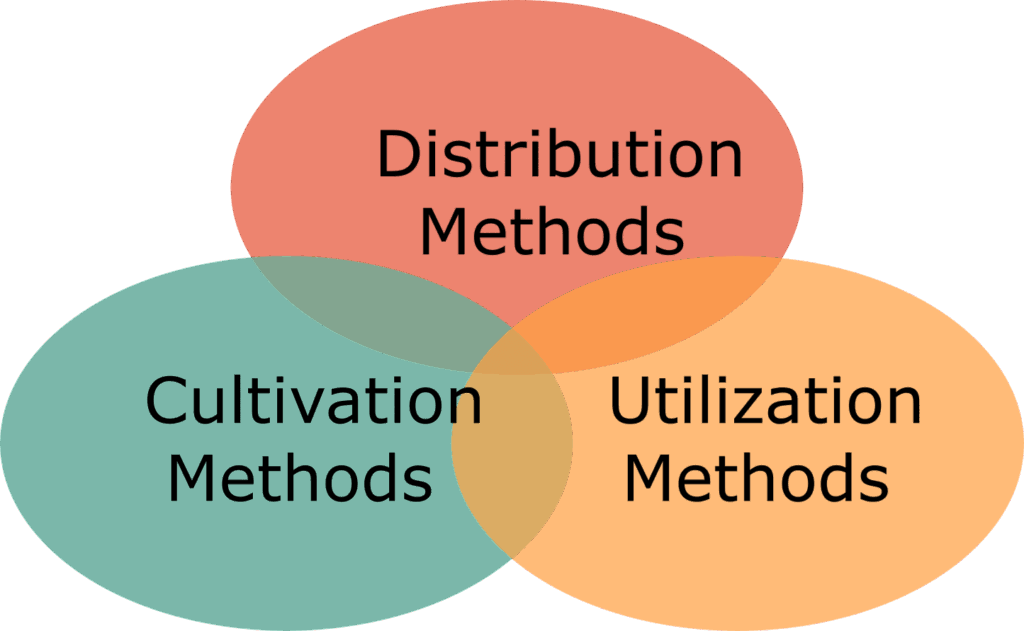
1−2. Principles of Synecoculture
Synecoculture is a method of farming that creates an ecosystem which naturally cultivates edible produce. The most efficient way to build this ecosystem is to increase the diversity of species that colonize the area and to control the various inhabitants. In addition to species diversity, genetic diversity is also encouraged by a wide variety of breeds within the same species, and the diversity of the ecosystem is increased by a colonized vegetation that adapts to a variety of environmental conditions. The diversity of genes, species, and ecosystems is referred to as biodiversity.
Biodiversity and ecosystem functions work as a system that supplements each other. The rich and robust biodiversity improves ecosystem functions. In turn, improved ecosystem functions adjust the environmental conditions in an optimum range such as temperature, humidity, amount of sunlight, organic matter and chemical composition of the soil so that more life forms can live in the environment, allowing a richer biodiversity. This mechanism provides a variety of ecosystem services necessary for human life including food production.
Synecoculture aims to create sustainable food production and autonomous economic activity by using multi-faceted knowledge of ecology to comprehensively improve biodiversity, ecosystem functions, and ecosystem services.
Tip
The necessary condition for establishing synecoculture is ecological optimization of the farmland. The sufficient condition for professional farmers, premised on competitiveness in agricultural markets, is economic self-sufficiency achieved through the valuation and sale of diverse products in both quality and quantity. Only when both are fulfilled can synecoculture be established as a livelihood.
Meanwhile, when synecoculture becomes one pillar of livelihood—not limited to professional farmers—by connecting with diverse social activities, and when it contributes to enhancing overall biodiversity and ecosystem functions, it fulfills the conditions for establishing itself as a shared natural-social common capital, which includes vital non-market values essential for sustainability [Funahashi 2025] .

As one implements the Synecoculture and starts to build the ecosystem, the biodiversity within a farm improves over time. It approaches the target vegetation state in a manner similar to sigmoid-type growth.In the first half of the sigmoid, a healthy plant tissue provided by ecological optimum state that Synecoculture aims for may not be reached, but it does create self-supporting consumption in home garden-like environments.
In the second half of the sigmoid, the saturation stage, biodiversity and ecosystem functions are sufficiently and densely established, gradually approaching ecological optimum. Only upon reaching this stage are the prerequisites for synecoculture met, enabling the sale of its products. Furthermore, once the economic value of diverse products is realized and harvest levels sufficient for a viable livelihood are achieved, allowing for autonomous economic activity, it establishes itself as professional farmers’ synecoculture.On the other hand, it is also important for the future as a social infrastructure that comprehensively supports the environment and food production to not only focus on production as a full-time farmer, but also to make synecoculture one of the pillars of life and collaborate with more diverse social activities.
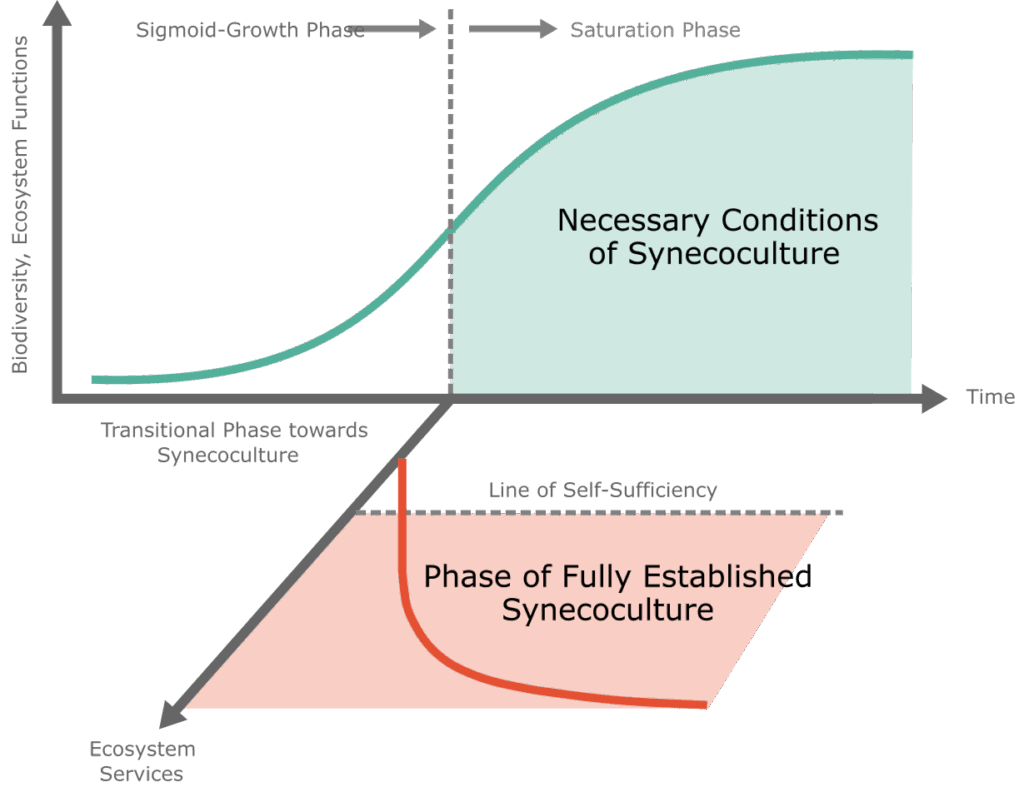
In order to maintain sustainable productivity from the ecologically optimized vegetation of Synecoculture without compromising ecosystem functionality, it is necessary to harvest from the saturation stage, not from the growth stage of the ecosystem construction. In practical assessment, if diversity of species in the Synecoculture plantation exceeds that of the surrounding natural environment with equivalent vegetation stage, we can safely say it has fully entered the saturation stage.Since the settled species within the plantation are considered to be demonstrating ecosystem functionality as a part of on-farm ecological optimum, harboring species diversity beyond naturally saturated environment is sufficient for the judgement.
As a specific management method, we can promote symbiosis not by completely eliminating naturally occurring weeds, but by selectively utilizing them with useful plants we introduce to construct the ecosystem.
The fact that Synecoculture can be practiced without plowing, fertilizers, or pesticides/herbicides is the result of ecosystem construction; simply leaving the farm untouched does not achieve Synecoculture.Therefore, it is necessary to actively introduce useful plants into the ecosystem, and to plan every step towards biodiversity. Disturbance, ecological niche formation(optimum environment for growth) following the introduction of useful plants, and controlling of food chain to regulate the fauna, all need to be incorporated into the plan to maximize its effect.As a result the methods necessary in conventional farming – plowing, fertilization, pesticides are replaced with disturbances in the form to promote biodiversity, formation of ecological niches, and a controlled food chain respectively.
Synecoculture could potentially create a huge number of different ecosystems because there is as much variety as there is the combination of natural vegetation and useful plants one introduces. It implies that we could achieve biodiversity on a scale that we have never seen in the biological history. Therefore, it is necessary to always be aware of and think about the big picture; what stage of succession your farm is positioned in an ecosystem, and where it is heading.
The core principle of Synecoculture is based on the evolutionary history of life on earth; primitive forms of life found their way on dry land, and over billions of years they evolved and created a complex system of topsoil that nurtures many forms of life. When constructing a synecocultural ecosystem, you can use this evolutionary history as a point of reference to assess the stages of your farm’s ecological succession.
As life evolved on land, plant species developed to grow tall with roots deep into the ground, and strengthened the adaptability to environmental changes. Many plant species of present time inherited these traits. Therefore, we can take advantage of these traits when transforming a deserted land with ecological succession into any stage through self-perpetuating climax community.To be more specific, your farm’s vegetation should expand in succession that recapitulates the chronological order of plants evolution: starting from annual plant, perennial plant, creeper plant, low trees, and to high trees. This method makes smooth ecological succession possible, and you can also strategize the production schedule of useful plants that best suits for each stage of succession. In some cases, skipping or reversing the succession stage can be an effective strategy to promote biodiversity.
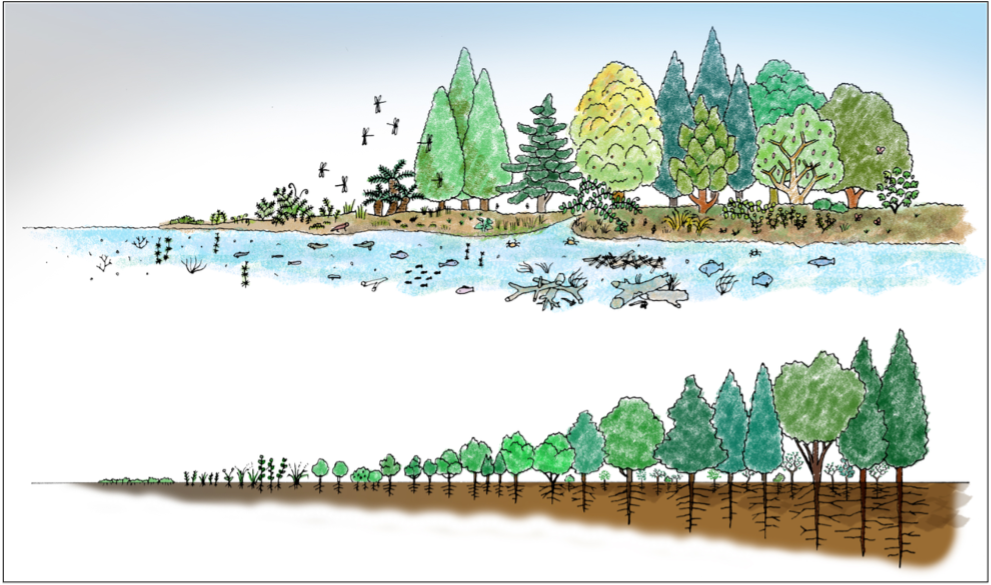
Tip
In biology there is a recapitulation theory that states « ontogeny mimics phylogeny », but in Synecoculture we manage the farm based on the view that states « ecological succession mimics evolution of land-based life». [Funahashi 2019] In order to develop a substrate devoid of life, start planting with the strong and low height annual plant, then the perennial, the creeper plants, then gradually introduce low trees then on to high trees. This process will leads to an abundant forest. There is a homology in traits between ecological succession and evolutionary history of marine life that adapted, over incredibly long period, to live on a dry land that was inhabitable once.
In conventional farming methods, mono cropping (making a single crop on a same land year after year) leads to the soil depletion. In Synecoculture, varying degrees of growth rate among useful plants and naturally occurring plants prevents the soil depletion, and vegetation transforms itself to a new ecosystem.
To increase the biodiversity in each vegetation stage and ecological succession, the following three species diversity indicators are useful in making evaluations.
α Diversity: species diversity at one vegetation stage. eg. species diversity of annual plants
β Diversity: species diversity that corresponds to the difference between two vegetation stages. eg. species diversity among annual plant and perennial plant that are independent from each other
γ Diversity: species diversity at all vegetation stages. eg. Synecoculture farm and all the species diversity of the surrounding ecosystem
Maximum biodiversity can be established by managing Synecoculture farm so that these three indicators improve simultaneously. As a result, Synecoculture is expected to restore and augment the biodiversity in both natural and urban environment.
For example, if there are two ecosystems with the same number of γ Diversity of 500 species, one could have less α Diversity in a stage than others, and another could have a partially lower β Diversity in vegetation. Thus, it is essential to diversify vegetation from both micro and macro perspectives.


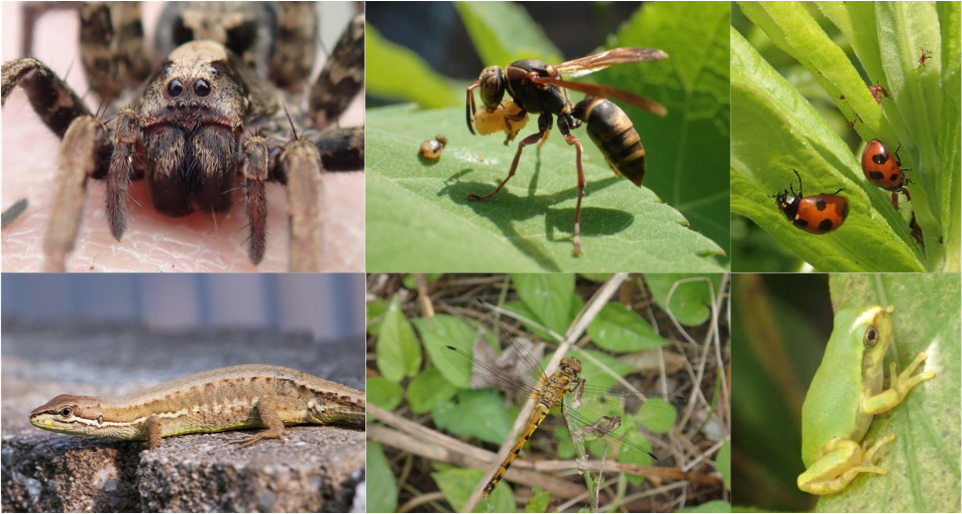
Tip
One of the major differences between Synecoculture and other farming methods is the restoration and development of the land through farming. Unlike other farming methods in which the natural environment is often harmfully exploited, Synecoculture farming can have a restorative effect on the ecosystem. The most remarkable example of this was the introduction of Synecoculture in an arid tropical region that was on the verge of desertification (see 5. Synecoculture in Different Climate ).
Within any given ecosystem , there are the factors of plants and animals taking the resources necessary for survival, production and decomposition of organic matter, and the circulation of nutrients.
Ecosystem services can be divided up into 5 major services – “supply services” that create and supply things like food and water, “regulation services” in which things like climate are controlled, “cultural services” which provide benefits for recreation, mental, and cultural aspects, “infrastructure services” that are responsible for nutrient circulation and the supply of oxygen needed for photosynthesis, and “conservation services” which preserve diversity and protects the environment from unforeseen accidents.
1-3. Productivity
As productivity fluctuates corresponding to environmental conditions and the type of plant species, it is necessary to consider both diversity and adaptability to various conditions comprehensively. In regular farming methods, where a single crop is cultivated repeatedly in the same conditions, the average value of the yield is indicative of productivity. However for Synecoculture, where farming is based on evolving conditions and the crop groups are constantly changing, that average value has no meaning within a pre-determined framework. It will be necessary to evaluate the net productivity as we adapt and diversify the vegetation strategy.
For the production volume of each crop, the leafy vegetables grown at the surface of the ridge exhibit the highest yield. While for crops that take up a lot of area of the land in comparison to the cultivation period, such as Chinese cabbage, tend to have relatively low yield.For fruits and grains such as wheat and rice, the harvest period is predetermined, so it is not possible to reach a production volume of conventional farming methods for a single species. You can still cultivate some amount of grain as mulch by mixing in with other vegetables. This way, it is possible to grow grains with a normal plant tissue that is not bloated with fertilizer.
A scientifically verified example of the productivity of Synecoculture in Japan is the performance achieved at Ise Farm over four years (2010–2014). For vegetables and fruits shipped during this period, the profit calculated as total sales revenue per 1,000 square meters minus maintenance costs was approximately 2.4 to 3.9 times that of conventional farming methods [Funabashi 2024]).
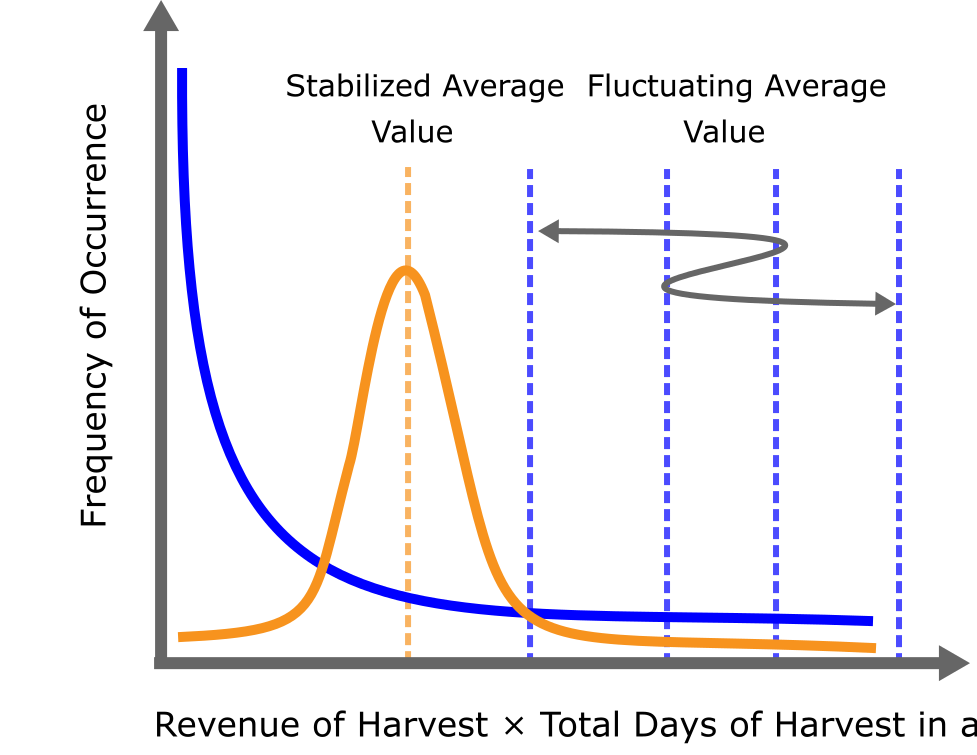
Tip
<Power Law Distribution Yield> Although the yield produced through conventional farming creates a bell-shaped “normal distribution,” the yield produced through Synecoculture is based on the so-called “power law distribution” to create vegetation in a natural state.The power law distribution appears widely in natural phenomena like, for example the scale and frequency of earthquakes. As earthquakes of lesser magnitude occur more frequently than do earthquakes of greater magnitude, in Synecoculture, small harvest of a variety of plants can be attained from many different environment, but large harvest from single species or environmental conditions is rarely observed. Since it fluctuates greatly in rare events, the average values of power law distribution should not be used as a predictive indicator. As Synecoculture production could greatly increase through rare large harvests, it will be necessary to update the yield description according to the evaluations of each step. In order to stabilize the fluctuating production that is the cause of power law distribution, the Synecoculture of various crops in the “portfolio” should be managed like an equity investment.
1-4. Management Conditions
As a basic principle, Synecoculture is a non-cultivation, non-fertilizer, and chemical-free farming method. Generally, humans can bring only seeds and seedlings into a Synecoculture farm. Nitrogen, phosphorus acid, potassium, organic matter, and other trace elements are provided solely by the vegetation within the farm and the animals that are attracted from surrounding environment. Generally, aside from the initial soil improvement, soil enhancers and probiotics (soil microbes) as well as artificial mulch must not be introduced during the entire cultivation process. Even leaf mold and pest repellant materials used in other natural farming methods are in violation of this principle. What can be used is otherwise specified in a range that does not interfere with the soil formation in terms of the definition in Synecoculture (see 2-2-6. Alternatives to Fertilization (Method of Recovering Productivity) ).
Management after the initial implementation is limited to three tasks: harvesting the crops, managing of the grass, and planting of seeds and seedlings.Grass management is carried out in accordance with the characteristics of each species of grass, however as a basic rule, annual grass stays and the perennial grass is removed.
Management tasks are easier to handle for ecosystems when performed frequently each day with low intensity. However, when gathering people for intensive work, it is better to focus 70-80% of management tasks within 20-30% of the total management time, rather than completing everything at once. This allows the remaining 70-80% of time to be used for individual light tasks or observation, totaling 20-30%, which better aligns with the ecosystem’s rhythm.
Tip
<The Difference between Annual Grass and Perennial Grass>
The roots of annual grass wither and decay in the soil, leaving pore spaces that are ideal for microbes. In contrast, roots of perennial grass keep growing without withering, and they tend to tighten the soil.However, perennials do provide organic matter and contributes to the diversity of microbes; thus, they can be utilized to play a different role than the annual plants.
In general, water should not be supplied by humans except for the following occasions: planting seedlings, after seed germination, and the times of severe drought. In these cases, using captured rainwater, water from a well or a river is more desirable than using tap water.
If you raise seedlings in a planter, it is permissible to use water and a minimum amount of fertilizer; however, residual fertilizer must be removed as much possible before planting in the Synecoculture farm.
In this regard, seedlings cultivated using chemical fertilizers and pesticides sold at home improvement stores and garden centers should not be brought in large quantities to the garden, as the amount used is unknown. Furthermore, seedlings grown rapidly with chemical fertilizers are fragile.

1−5. Vegetation Conditions
The mixing of multiple vegetables, which are densely populated, is a primary rule. Annual weeds are allowed to the extent that vegetables do not lose out, and are utilized in the soil formation. It is ideal for the surface to be covered with plants throughout the year.
In evaluating the vegetation stage, the following guidelines show the degree of superiority and inferiority. Items towards the top are the most desirable conditions for Synecoculture while items near the bottom are less desirable.
Tip
In conventional farming methods, where single type of crop is planted in an interval, it ruins both the vegetation structure above ground and the soil structure underground, causing impaired ecosystem functions.The larger the surface area above and under ground that vegetation builds, the more biodiversity the soil can nurture.
Vegetables and fruit trees are densely mixed together, and vegetable mulch is formed with minimal amount of weeds.
▲
There are not many vegetables and fruit trees, however the field is covered by varieties of annual and perennial grass.
▲
The annual and perennial grasses are colonized and forming communities.
▲
Vegetation is destroyed through cultivation, and the topsoil is exposed.
▲
Excessive use of chemical fertilizers and monoculture have depleted the land, and it is heading towards desertification.
▲
Organic matter is plowed deep into underground due to cultivation.


Tip
In comparison between conventional farming methods and Synecoculture, the surface area produced by crops is substantially different for both above and under ground.As the vegetation structure becomes more complex, there will be a wider variety of coexisting organisms. Through the development of ecosystems, building the mechanism that contributes to productivity and risk management will be essential in Synecoculture.
1-6. Harvesting Method
In Synecoculture, harvesting is the primary method of management. Harvesting effectively thins the densely mixed vegetation and gives space and nutrition for next generation of vegetables. Start thinning with matured crops and vegetation that have reached high density.To minimize the labor cost, other management tasks should be conducted while harvesting. Empirically speaking, plains south of Kanto region in Japan do not have the agricultural off-seasons with Synecoculture. You can harvest year-round by thinning, provided that proper vegetation strategy is in place, and environmental conditions such as sunlight and the means to protect from wind are sufficient.For professional farmers who require frequent harvesting, it may be necessary to have a countermeasure (e.g. an extra nursery space) in the transition period of March and September when yield decreases.The northernmost limit where the off-season becomes absent varies due to factors such as topography, elevation, and climate change. With techniques like the open-type greenhouse described in the section 3-5-1. Examples of Structure , cultivation is possible in some regions
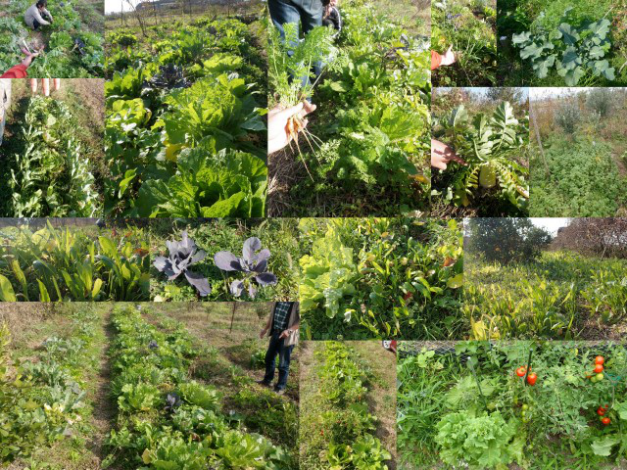
1-7. Management Principle: “Space-Time Seed” (Multi-faceted use of time – space – variety)
In Synecoculture, space is used efficiently in three dimensions to ensure constant harvest of multiple produce for prolonged period. Placement strategy and its management method should incorporate time, space, and produce types as an integrated system.
・Using Time : Transition of vegetation and seedling planting are planned and managed so that you can continuously harvest one crop after another on a daily basis. To achieve this, you can
- Shift the seedling planting period
- Diversify the environmental condition to create a difference in growth speed
- Save some produce in the field until they can be harvested in a time when overall produce is low in quantity.
The defining characteristic of Synecoculture is the multi-track usage of time (see 2-2-8. Sequence of Harvesting – Seedling Transplant – Overseeding).
Tip
Within one hectare of a Synecoculture field, it is possible to introduce over 200 types of commercially available vegetables and fruits. If taking breeds into account, a diversity of over 1,000 types can be achieved.Adding herbs and edible wild plants can also double the diversity, although the distribution amount of these seedlings is low. This means that humans can help to expand the biodiversity beyond its natural state. In response to the environmental destruction caused by population growth, introducing useful plants expands the ecosystem, which is vital for both food production and conserving the environment [Funabashi 2018] [Funahashi 2025] .
Though vegetables grown using conventional farming methods may have a harsh taste in some part, produce grown through Synecoculture have a differently pure taste and can even be eaten raw. In particular a wide, diverse range of flowers becomes an important product as a food item.Asparagus, broccoli, mountainous udo plant, etc. grown under Synecoculture have become popular produce items that many people preferably consume raw without boiling.
・ Using Space : To efficiently use the given space, utilize not just the ridge but all parts of the farm, and combine the plants with different shapes and physiological characteristics so they complement each other in three dimensions. The following are the examples of such an application:
- Creeper plants can be grown on the fences, passageways, areas around the farm, and on the tree trunks.
- Plant the crops that favor shade under the crops that favor sunlight.
- Plant crops with narrow vertical leaves, like green onion, in between the ones with wide horizontal leaves such as butterbur and burdock.
- Plant vegetables with different root length and spread patterns in a same space.
・ Using Variety : Not just vegetables, fruit trees, and herbs, but many useful plants such as edible wild plants will be mixed together. Even for the species with no growth record, if there is precedent of cultivation within the same climate zone, it may be introduced into the system. Additionally, separate parts of plants such as leaves, stems, shoots, buds, flowers, fruits, seeds, roots, etc., will be used as different products. In terms of application of the produce, you can develop variety of merchandise in a number of ways: vegetables can be sold raw or as seedlings, dried to make tea or spices, preserved to make pickles. You can even make and sell commodity items such as natural dye.
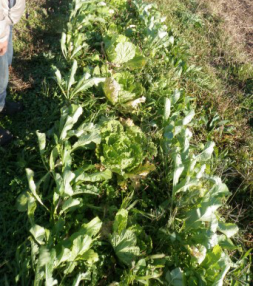
1-8. Cost
Aside from the initial construction materials, tree planting, seedling, and other maintenance fees, basically there is no need to purchase anything else. Heavy equipment such as tractors becomes unnecessary, and other farming tools are not needed. The only tools needed are scissors for harvesting, a shovel for seedling planting, and tools for cutting the grass (having one small-sized lawnmower would be convenient). The cost to purchase seedling, a part of maintenance fee, will gradually go down and will be replaced with homegrown seed from the farm. In an ideal situation, you want to keep cost of investment at 1/10th of the total revenue. For professional farmers with large field, the labor cost according to the scale is added to cover grass maintenance and harvesting throughout the year.
1-9. Search Method
When starting a new Synecoculture field, initial “trial and error” is necessary to identify what kind of useful plants can be grown in the particular location. By planting a single type of vegetable in varying conditions of sunlight exposure, humidity, soil quality, density, mixing with other species and with different preexisting vegetation, possible growth environment for the produce will be discovered. Out of all the plants you introduce, a small percentage should be always allocated to trying a new plants even though they may have little prospect in a given environment. There are precedents of crops that did not take roots at all for the first few years, but flourished and became farm’s primary revenue source as succession changed the environmental conditions over the years. By expanding the search field and not relying merely on past successes, the ability to respond flexibly to changes in the environment and ecosystems will increase. In vegetation strategy, it is desirable to consistently allocate 20-30% of resources toward exploring new possibilities.
Additionally, for vegetation that has yet to become useful, there have been many cases where it found new commercial value by applying multiple utilization methods such as using different parts, the cooking method, the plantation and harvesting period, and other usages. Even for parts that are not commonly used, and for usage methods that go against common sense, it is widely possible to invent new practical and valuable usages, which increase the resources that can be leveraged in the future as part of the ecosystem service, and may also become an important product in other regions. Utilization methods can also be expanded by finding new uses for vegetables that are already in the market.
Tip
In making effective assessment about the ecosystem in implementing Synecoculture at a high level, it is possible to engage a high level of information processing abilities, similar to that of the cognitive reaction of athletes and advanced medical diagnosis.Sony CSL is developing and has begun partially providing a Synecoculture support system utilizing information and communication technology to explore and utilize locally suitable useful plants and exchange knowledge, which is essential for practicing Synecoculture [Sony CSL] .